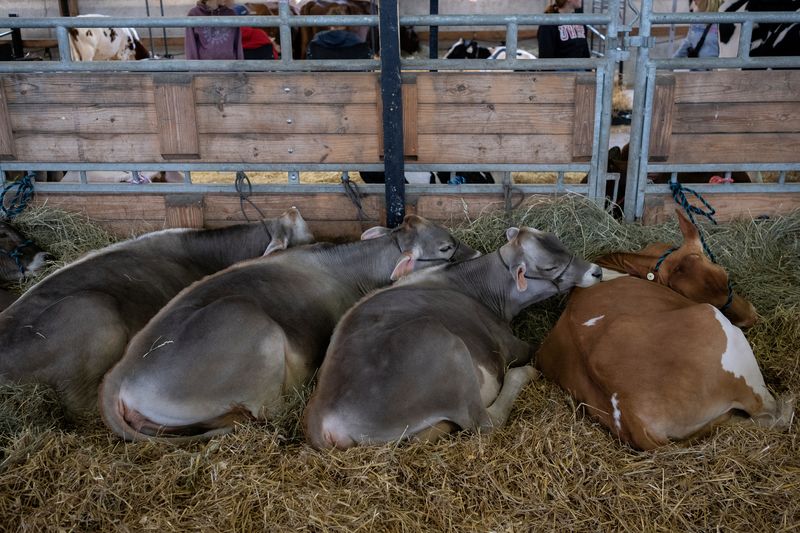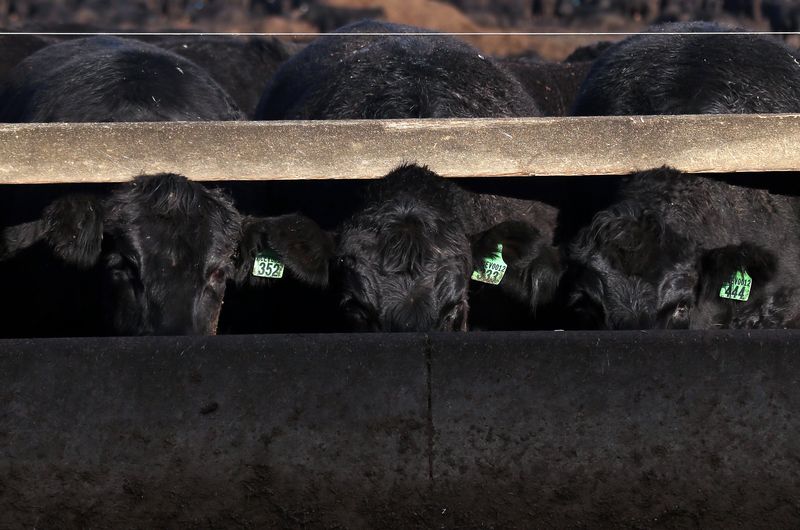By Tom Polansek and PJ Huffstutter
WEST ALLIS, Wis. (Reuters) – In Michigan, where dairy workers and herds have been sickened by bird flu this year, some unlikely prized cows are being prepared to take the stage at the state fair.
This year, state fair organizers are showcasing Milkshake and Buttercup, two life-size fiberglass cows complete with rubber teats and water-filled udders, for a popular milking demonstration.
The head of the Minnesota State Fair’s Moo Booth came up with a similar idea for the hands-on milking event: a fake dairy cow named Olympia.
“Normally we would have a real cow there,” said Jill Nathe, the fair’s deputy general manager of agriculture and competition. “We just can’t do that right now.”
As bird flu continues to spread, infecting cattle herds and four dairy workers for the first time this year, organizers of U.S. state and county fairs have been forced to reimagine nostalgic summer traditions long celebrated by urban and rural residents alike.
For farmers and students longing for blue ribbons and bragging rights, the outbreak has forced them to adopt new testing rules and manage logistical issues to obtain a clean bill of health for animals before entering the show ring.
State and local officials say they are trying to protect people and animals from the H5N1 virus as some dairy farmers have refused to test their herds. Experts are concerned that further transmission of the virus could help it adapt to spreading between people.
The risk of virus spread among herds prompted some county fairs in Michigan to cancel dairy shows, while the Iowa State Fair closed its parlors.
In Minnesota, state fair staff purchased extra gloves and face shields from COVID-era supplies for livestock staff and kept pregnant dairy cows out of the fair’s birthing center.
Several agricultural states, including Wisconsin, required lactating cattle to test negative within seven days of arriving at the fairgrounds.
Wisconsin dairy farmer Rick “RT” Thompson said he had to carefully time his veterinarian’s visits so that milk test results for H5N1 would fall within the required time frame for various fairs. His veterinarian’s wife personally took the samples to a state laboratory in Madison to ensure they arrived in time for testing.
“It’s not convenient,” said Thompson, 57, who has attended the Wisconsin State Fair for 46 years.
Michigan banned lactating cows from all public exhibitions until the state has not found an infected herd for two months. With only one state fair per year, the window of opportunity has expired before 2024. Michigan last reported a case on Monday.
“We were all waiting for that 60-day period,” said LC Scramlin, livestock director for the Michigan State Fair. “But we kept getting another case and another one happened.”
COWS STAY AT HOME
At the Wisconsin State Fair, where visitors can buy everything from cream puffs to bubble baths, veterinarians inspected livestock before they stepped off the trailer to make sure the animals were healthy upon arrival — a departure from previous years, exhibitors said.
The risk of bird flu was enough to convince Jennifer and Bethany Droessler to keep a lactating cow at home. The sisters from Cuba City, Wisconsin, instead transported other livestock to display at the event’s Dairy Lane, where fairgoers petted each other and took selfies with animals that topped the scales at more than 1,000 pounds.
“We’re aiming for next year and hopefully it won’t be a problem,” said Jennifer Droessler, 30.
Since March, more than 190 dairy farms across the country have been infected, and 13 farm workers tested positive after exposure to cows and poultry.
The workers all recovered, and the U.S. Centers for Disease Control and Prevention says H5N1 remains a low risk to the general public. Still, the CDC advises people not to eat, drink or touch anything in the animal areas at fairs.

Several fair attendees in Wisconsin, the world’s second-largest milk producer and largest cheese-producing state, said they were unaware of or concerned about the guidelines. Visitors munched on treats including taffy apples and cheese curds as they strolled among ruminating cows.
“I don’t think it’s a big risk,” said OE Glieber of Delafield, Wis., 88, who came to the fair with grandchildren. “The CDC is overreacting with a lot of things.”


